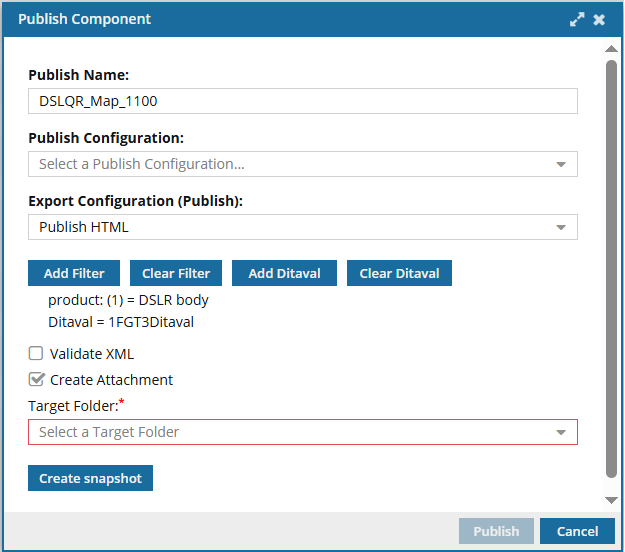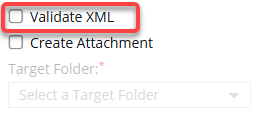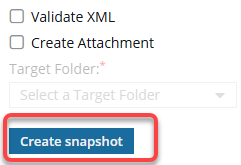DOCX is the file format used by Microsoft Word to store documents. The DOCX format does include XML. For some customers, Inspire provides a publishing configuration and a publishing plug-in for DOCX.
 You may not have permissions to publish under the following conditions:
You may not have permissions to publish under the following conditions:
- A content owner or administrator can set permissions to deny access to components or folders. If your permissions to content has been blocked and you are not an administrator, you can use the Publish option in a project's Content pane, but it will fail with a warning.
- An Inspire administrator can define at the user and role level whether the Publish action is available.
- By default, only administrators can publish content in Inspire.
- You can see the Publish option only if you're an administrator or have the can_publish module property.

 Before you begin
Before you begin
- If you don't see the DOCX options described in this topic, contact your Vasont salesperson to purchase this feature.

 Tips and tricks
Tips and tricks
If the DOCX publishing option is supported for your organization, when you publish a component, on the Publish Component screen, you can select the Publish Docx option.
If published successfully, you can download a deliverable in the DOCX file format that you can open in Microsoft Word.
- Set notifications: If you have changed the defaults and want to see publishing notifications, make sure you configure them before publishing. Follow the steps in Set notification preferences for publishing.
- Use a Publish Configuration. The same settings on the Publish Component screen can also be set by an administrator in the Publish Configuration.
- If you select options on the Publish Component screen, your settings are used even if they are in conflict with the Publish Configuration that an admin creates.
- If you select options on the Publish Component screen that don't conflict with the Publish Configuration that an admin creates, then both sets of options are used.
- Publish a map with a DitaVal file: Ditaval files specify the conditions to include and exclude when you generate your map's output. DitaVal files are useful if you're using conditional attributes extensively in your documentation.
 You can select only one DitaVal file when publishing a map.
You can select only one DitaVal file when publishing a map.
 If you're publishing a map, follow the steps in: Publish from a map.
If you're publishing a map, follow the steps in: Publish from a map.
- Use tokens in the Publish Name: When publishing a component or from a profile, you can optionally use a token in the job's Publish Name to pull in data so you don't have to type it in every time you send the component out for publishing.
- Other places where you can publish. Anywhere you can access a component you can select the Publish option.


To publish an Inspire component as a DOCX file:
-
Click
 Components.
Components.
-
In the Folders pane, locate the component that you want to publish.
-
In the Components pane, right-click the component and then select Publish.
 Result: The Publish Component screen opens.
Result: The Publish Component screen opens.

 You only see the Add Ditaval button if you are publishing a map as DOCX.
You only see the Add Ditaval button if you are publishing a map as DOCX.
-
By default, Inspire provides a Publish Name for your publishing request (job) using the component's File Name without the GUID. You can do any of the following to this job name:
- Optionally, you can change the Publish Name to a different set of characters.
- Use 1000 characters or less
- You must use underscores (_) instead of spaces.
- Select a Publish Configuration to populate the Publish Name.
- If the configuration includes a Publish Name, it overwrites anything previously used or entered into this field.
- If the configuration does not include a Publish Name, you can leave the default of the component's File Name or enter a new name.
If you leave Publish Name empty, Inspire uses the component's File Name without the GUID.
- To add a token to the Publish Name when publishing a component, follow the steps in Publish a component with tokens.
Examples of ways you can use a token in the job's Publish Name field:
- To add the name of the MyMap component, use
{$componentname}  Example Publish Name = MyMap
Example Publish Name = MyMap
- To add the topic title of the MyMap component, use
{$title} Example Publish Name = UserManual
Example Publish Name = UserManual
- To add the file name of the MyMap component, use
{$filename}  Example Publish Name = MyMap_ceb80930-0712-48d2-92a5-9c2ee7d2ff7d.xml
Example Publish Name = MyMap_ceb80930-0712-48d2-92a5-9c2ee7d2ff7d.xml
- To add the current date and time to the job name for MyMap, use
{$datetime}  Example Publish Name = MyMap2024-04-30-111017
Example Publish Name = MyMap2024-04-30-111017
- To add the name of the user who created the publishing job for MyMap, use
{$username}  Example Publish Name = MyMapjanedoe@mycompany.org
Example Publish Name = MyMapjanedoe@mycompany.org
- To add the code for the language used in the component MyMap, use
{$langcode}  Example Publish Name = MyMapen-US
Example Publish Name = MyMapen-US
- To add the name of the language used in the component MyMap, use
{$langname} Example Publish Name = MyMapEnglish
Example Publish Name = MyMapEnglish
 If you need a system variable that isn't in the list of examples, contact your Inspire support representative.
If you need a system variable that isn't in the list of examples, contact your Inspire support representative.
-
Optionally, in Publish Configuration, select the publish settings you want to use.
This configuration is created by an administrator and includes settings such as populating the Publish Name, identifying the export process to use, validating XML, and using profiling attribute filters.

An administrator can choose a
Publish Configuration to be shown automatically as the default. If you need to use something other than the default, you can select another option.
 The same settings on the Publish Component screen can also be set by an administrator in the Publish Configuration.
The same settings on the Publish Component screen can also be set by an administrator in the Publish Configuration.
- If you select options on the Publish Component screen, your settings are used even if they are in conflict with the Publish Configuration that an admin creates.
- If you select options on the Publish Component screen that don't conflict with the Publish Configuration that an admin creates, then both sets of options are used.

For some customers, Inspire provides a publishing configuration and a publishing plug-in for DOCX. If it's supported for your organization, you can select the
Publish Docx option.
-
In Export Configuration (Publish), select the format as Publish Docx.
-
If you've applied profiling attributes to content in the component you're publishing, you can use filters.
-
To choose the profiling attributes you want included in the publishing job, click Add Filter.
-
On the Filter profiling attributes tab, do any of the following:
- Select the individual options you want to transform the content you are publishing.
- In Saved Filters, select a defined collection of attribute filters.
-
On the Filter profiling attributes screen, click Select.
 Result: You see the profiling attributes you select on the Publish Component dialog, listed after the Clear Filter button.
Result: You see the profiling attributes you select on the Publish Component dialog, listed after the Clear Filter button.
-
When you're publishing a map, you can optionally select a DitaVal file that already exists in Inspire.

 You can only select one DitaVal file.
You can only select one DitaVal file.
-
On the Publish Component screen, click Add Ditaval.
-
On the Add Ditaval screen, click
 Add.
Add.
-
On the Select Components screen, search for or browse to the folder where the Ditaval file is saved.
-
Select the checkbox for a DitaVal file and click Select.
 Result: You see the name of the DitaVal file you selected on the Publish Component screen.
Result: You see the name of the DitaVal file you selected on the Publish Component screen.
-
If you want to verify that your XML code in your component is valid according to your framework at the time of publishing, select the Validate XML option.


By default this option is not selected.
-
If you want to import the published deliverable back into Inspire automatically, select Create Attachment.
-
In Target Folder, select the location where you want the publish deliverable saved.
 The file is saved as a binary. By default, it is named using the following default format: Publish-{ComponentName}-YYYY-MM-DD-HHHHMM. However, an administrator can configure Inspire to omit the timestamp from the published file name.
The file is saved as a binary. By default, it is named using the following default format: Publish-{ComponentName}-YYYY-MM-DD-HHHHMM. However, an administrator can configure Inspire to omit the timestamp from the published file name.
-
To add a snapshot to the history for this component and all referenced content, click Create snapshot.
-
On the Create snapshot dialog, in Name, enter a descriptive title for the version in 50 characters or less.
-
Optionally, in Comment, enter additional information differentiating this version from other snapshots in 2000 characters or less.
-
On the Create snapshot dialog, click Create.
 Result:
Result: You see a component snapshot labeled
On Demand on the
History tab. Look in
Component details for a list of the components that were included when you created the snapshot. Follow the steps in:
View a snapshot -
On the Publish Component dialog, click Publish.
 Result:
Result: In the top-right corner, you see a message that Inspire is preparing your publishing job.

After Inspire successfully submits the job, you receive a notification that you can review on the Notifications tab, in Slack if it's configured for notifications, and in email.
 Tips and tricks
Tips and tricks
- You can use Publish Server to see job status and histories, download files related to a job, and re-publish content from an existing job. To learn about job management, read Welcome to Publish Server.
- Open Publish Server from a link in the following places:
- For the DOCX publishing formats, you download a single standalone file
- By default, when you select one component to publish, Inspire provides a Publish Name using the component's File Name without the GUID. You can change the Publish Name, and you see it on the Publish portal in the Title column.
- The Publish Name is not the same as the deliverable (published content) name.
- You can create whatever job Name you want.
- Deliverables are named by Inspire using the following default format: Publish-{ComponentName}-YYYY-MM-DD-HHHHMM. However, an administrator can configure Inspire to omit the timestamp from the published file name.
 You may not have permissions to publish under the following conditions:
You may not have permissions to publish under the following conditions:
 Before you begin
Before you begin
 Tips and tricks
Tips and tricks You can select only one DitaVal file when publishing a map.
You can select only one DitaVal file when publishing a map. If you're publishing a map, follow the steps in: Publish from a map.
If you're publishing a map, follow the steps in: Publish from a map.


 Result: The
Result: The 
 If you need a system variable that isn't in the list of examples, contact your Inspire support representative.
If you need a system variable that isn't in the list of examples, contact your Inspire support representative. 
 An administrator can choose a
An administrator can choose a  For some customers, Inspire provides a publishing configuration and a publishing plug-in for DOCX. If it's supported for your organization, you can select the
For some customers, Inspire provides a publishing configuration and a publishing plug-in for DOCX. If it's supported for your organization, you can select the 






 notification after you submit a publishing job or
notification after you submit a publishing job or 
 Go to Publish Server
Go to Publish Server